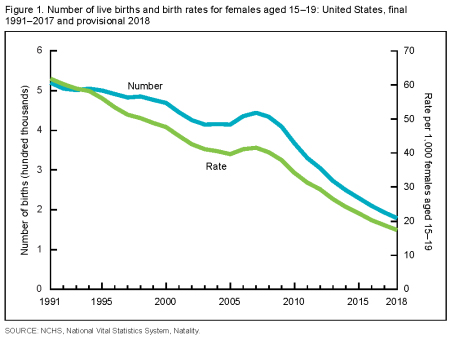The Short List of Major Healthcare Implications from A Declining Birth Rate
By Clive Riddle, May 17, 2019
Like most of the industrialized world. the U.S. birth rate is declining, as evidenced in the new CDC National Center for Health Statistics National Vital Statistics System May 2019 report on "Births: Provisional Data for 2018." (the final birth report is scheduled to come out this fall.) The big news from the report is the number of births was the lowest in 32 years, and the fertility rate reached another record low.
Here's highlights from the report:
- The provisional number of births for the United States in 2018 was
- 3,788,235, down 2% from 2017
- The general fertility rate was 59.0 births per 1,000 women aged 15–44, down 2% from 2017 a
- The total fertility rate declined 2% to 1,728.0 births per 1,000 women in 2018
- Birth rates declined for nearly all age groups of women under 35, but rose for women in their late 30s and early 40s
- The birth rate for teenagers aged 15–19 was down 7% in 2018 to 17.4 births per 1,000 women
- Rates declined for both younger (aged 15–17) and older (aged 18–19) teenagers
- The cesarean delivery rate decreased to 31.9% in 2018; the low-risk cesarean delivery rate decreased to 25.9%
- The preterm birth rate rose for the fourth year in a row to 10.02% in 2018
- The 2018 rate of low birthweight was unchanged from 2017 (8.28%)

In a Q&A session with report author Brady E. Hamilton, Ph.D. posted in the NCHStats blog, Hamilton is asked if there was a specific finding that surprised him, which he replied "the record lows reached for the general fertility rate, the total fertility rate and birth rates for females aged 15-19, 15-17, 18-19, and 20-24 are noteworthy. In addition, the magnitude of the continued decline in the birth rate for teens aged 15-19, down 7% from 2017 to 2018, is also historic." Hamilton was non-committal about the trend going forward, stating “these data do not answer the question of why the number of births dropped in 2018 or if the decline will continue.”
But assuming the trends do continue, which certainly the opinion of many, there are certainly major implications for healthcare, including this short-list:
- Impact of reduced demand for hospital and physician OB services
- Impact of increased births from higher-age mothers, with greater care complexities involved
- Longer range reduced demand for hospital and physician pediatric services
- Longer range reduced available Medicare funding from employed workforce, with growing imbalance of senior retired population compared to working population
 Post a Comment By
Post a Comment By  Riddle, Clive |
Riddle, Clive |  Friday, May 17, 2019 at 01:37PM tagged
Friday, May 17, 2019 at 01:37PM tagged  Surveys & Reports|
Surveys & Reports|  Trends & Strategies
Trends & Strategies 

Reader Comments